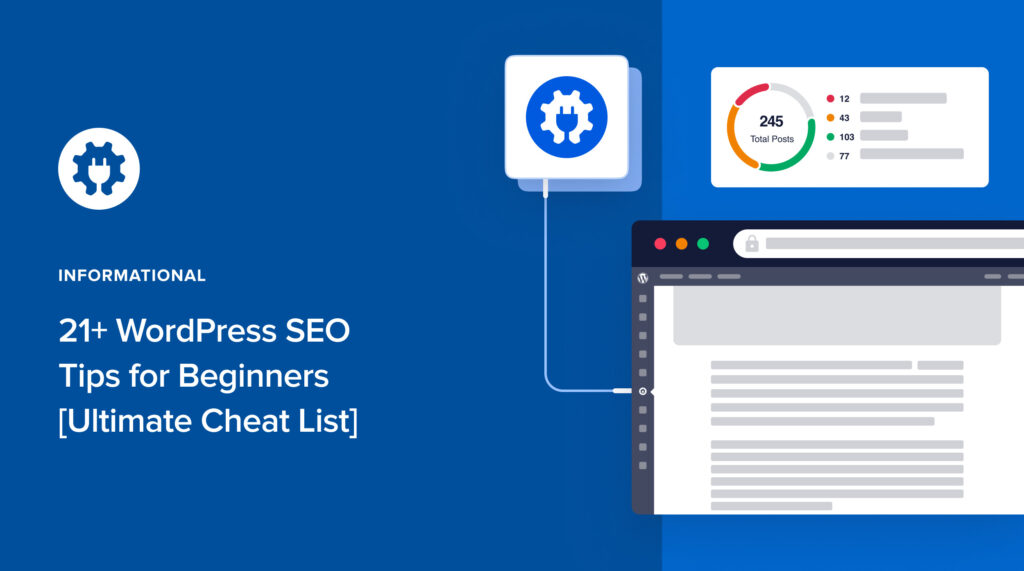Looking for effective WordPress SEO tips for beginners?
If you’re starting out, the world of WordPress can be quite daunting. Couple that with SEO, and you may feel like ranking your site, and content may require some sort of wizardry.
However, you only need to learn the basics of both disciplines.
In this article, we’ll show you some of the top WordPress SEO tips for beginners. These will help you rank better on search engine results pages (SERPs) and drive more traffic to your site.
In This Article
- What is SEO?
- Is WordPress Still the Best for SEO?
- WordPress SEO Tips: Getting the Basics Right
- On-page SEO Tips
- 4. Keyword Research
- 5. Understand Search Intent
- 6. Keyword Optimization
- 7. Focus on Content Quality
- 8. Build Topic Clusters
- 9. Use SEO-friendly URL Structures
- 10. Watch Your Image SEO
- 11. Optimizing Search Snippets (SEO Title Tag and Meta Tag)
- 12. Add Internal Links
- 13. Implement Google E-E-A-T
- 14. Target Google’s People Also Ask (PAA) Section
- Off-page SEO Tips
- Technical SEO Tips
- WordPress SEO Tips: Your FAQs Answered:
- Master WordPress SEO for Better Search Rankings
What is SEO?
Search Engine Optimization (SEO) is the practice of optimizing your website to improve its visibility on search engines like Google. The goal is to attract organic (non-paid) traffic by ranking higher in search engine results. In this guide, we’ll explore how to leverage the power of SEO specifically for WordPress websites.
Is WordPress Still the Best for SEO?
WordPress remains one of the most popular content management systems (CMs) for some good reasons. One is that it’s super easy to use. But for most users, it’s the flexibility it gives regarding optimizing your site for discoverability in search (SEO). Plus, being an open-source platform, you’ll find many plugins to help you create the perfect site for your needs,
That’s why, if you’re still on the fence about building your website using WordPress or another CMS, we recommend you go the WordPress route. Whether you’re a beginner or an experienced user, we’re pretty sure you’ll love the WordPress experience, especially when you see just how easy WordPress SEO is.
That’s why we want to show you these WordPress SEO tips so you can hit the ground running, even if your site is new.
WordPress SEO Tips: Getting the Basics Right
1. Use the Right WordPress SEO Tool
One of the most important WordPress SEO tips is to use the right SEO tool. And for WordPress users, there’s no better tool than All In One SEO (AIOSEO).
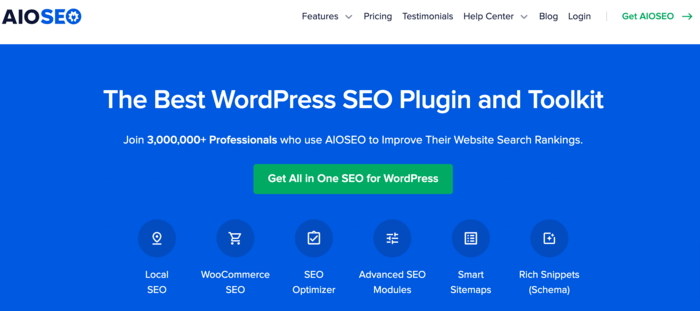
AIOSEO is a powerful yet easy-to-use SEO plugin that has been downloaded over 100 million times. Millions of smart bloggers use AIOSEO to help them boost their search engine rankings and drive qualified traffic to their blogs. That’s because the plugin has many powerful features and modules designed to help you properly configure your SEO settings. Examples include:
- Cornerstone Content: Easily build topic clusters and enhance your topical authority and semantic SEO strategy.
- Search Statistics: This powerful Google Search Console integration lets you track your keyword rankings and see important SEO metrics with 1-click, and more.
- SEO Revisions: Track any changes you make to your site and see their impact on your SEO. Plus, you get to see on a timeline how Google updates affect your site.
- Advanced Robots.txt Generator: Easily generate and customize your robots.txt file for better crawling and indexing.
- TruSEO Highlighter: Makes it easy to spot on-page SEO issues and gives recommendations for fixing them.
- Next-gen Schema generator: This no-code schema generator enables users to generate and output any schema markup on your site.
- Redirection Manager: Helps you manage redirects and eliminate 404 errors, making it easier for search engines to crawl and index your site.
- Link Assistant: Powerful internal linking tool that automates building links between pages on your site. It also gives you an audit of outbound links.
- SEO Preview: This gives you an overview of your search and social snippets and general SEO so you can improve your optimization.
- IndexNow: For fast indexing on search engines that support the IndexNow protocol (like Bing and Yandex).
- Sitemap generator: Automatically generate different types of sitemaps to notify all search engines of any updates on your site.
- And more.
AIOSEO also has many other features to help you boost your local SEO, on-page SEO, and technical SEO. Plus, if you’re a WooCommerce user, AIOSEO has a tailor-made WooCommerce SEO module to help you rank your online store higher in search rankings.
For step-by-step instructions on how to install AIOSEO, check our detailed installation guide.
2. Ensure Your Pages are Indexed
Another essential WordPress SEO tip is ensuring that search engines index your posts and pages.
Indexing simply refers to the process search engines use to store information about web pages in their database. This makes it easy for them to pull up your URL for relevant search queries and present them on search engine results pages (SERPs).
If your website isn’t in Google’s index, users won’t find your website in search results. That’s why it’s critical to make sure your site is indexed. Don’t worry. You can easily check your index status right inside your WordPress dashboard using AIOSEO’s Index Status feature.
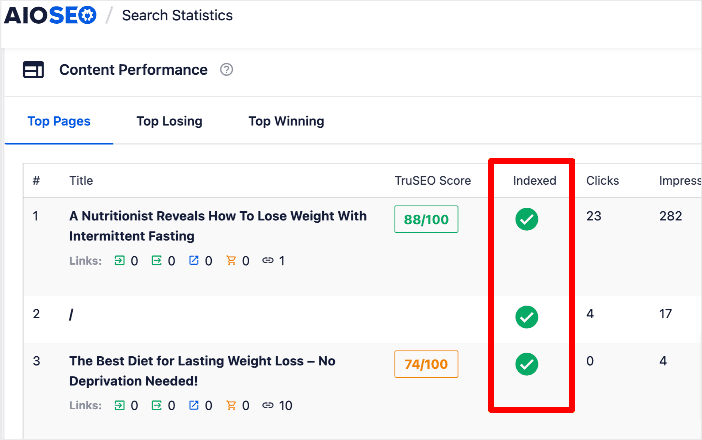
For improved indexing, check out our top tips for indexing your site faster on Google.
3. Optimize Your Robots.txt File
A robots.txt file is a powerful SEO tool that instructs search engines on how to interact with your site. You can use it to prioritize pages, disallow crawling of URLs, instruct search engines when to crawl your site and more. This is why optimizing your robots.txt ranks high on our list of top WordPress SEO tips for beginners.

You can easily generate and optimize your robots.txt file using AIOSEO’s advanced Robots.txt Editor. To access it, go to your AIOSEO menu » Tools » Robots.txt editor.
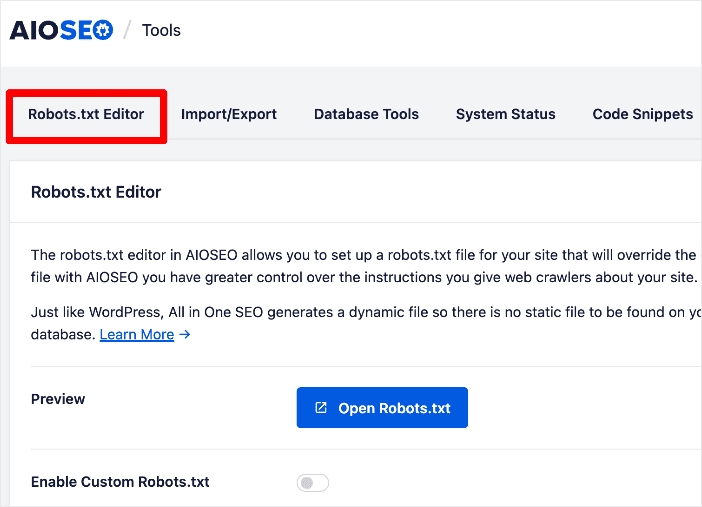
AIOSEO’s advanced Robots.txt Editor makes optimizing your robots.txt file easy, as it comes with many useful directives or instructions for search bots. Examples include directives like Allow, Disallow, Clean-param, and Crawl-delay.

It also allows you to import a robots.txt file from another site. This handy feature saves you a lot of time optimizing yours.
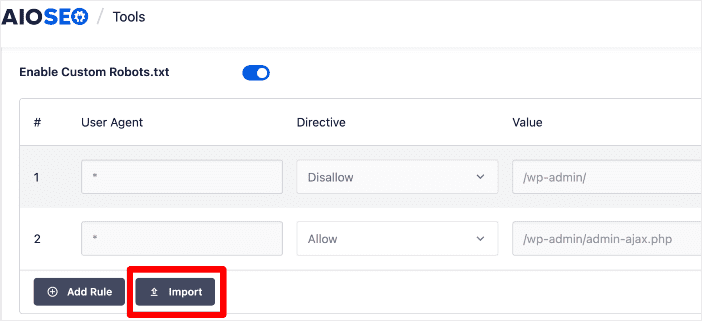
For more details, please visit our post on how to edit a robots.txt file in WordPress.
Getting these SEO foundations right ensures that your crucial pages rank high on search engines.
On-page SEO Tips
4. Keyword Research
Keyword research is a foundational aspect of SEO, particularly on-page SEO. This is because every search starts with a keyword.
Keyword research involves understanding the words, phrases, and questions your target audience uses when searching for information relevant to your business or product. It also involves strategic tasks like checking keyword difficulty and whether targeting those keywords is feasible.
There are many keyword research tools you can use to discover the keywords to target in your content.
5. Understand Search Intent
Once you discover your keywords, you should also try to find the intent behind the search. This is called search intent. While it may sound complicated, figuring out search intent is quite easy. Two of the best ways to do it are:
- Using tools: keyword research tools like Semrush have a search intent feature that helps highlight the most common user intent behind a keyword.
- Studying SERPs: Study the SERPs and see the type of content that ranks well.
Understanding search intent is important as it helps you improve your organic CTR, traffic, and engagement. Plus, since it’s an undervalued part of keyword research, this WordPress SEO tip will give you an edge over your competitors.
6. Keyword Optimization
Once you’ve done your keyword research, you also need to know how to use them in your content. This is called keyword optimization. A few tips for doing this include placing your keywords in your:
- URL
- Header tags
- Introduction and conclusion
- Meta description
- SEO title
Don’t overuse your keywords in your content, however, as this results in keyword stuffing, a practice search engines frown upon. To avoid keyword stuffing, look for synonyms and LSI keywords you can use. These have the advantage of boosting your semantic SEO.
7. Focus on Content Quality
Content quality is one of the most important WordPress SEO tips you should never compromise on. Bring your A-team when it comes to content creation. If you’re a solopreneur, then bring your A-game. This is because content quality is a huge ranking factor, particularly after Google’s Helpful Content Update (HCU). To ensure your content is of high quality:
- Do in-depth research
- Cover the topic thoroughly
- Meet user intent/search intent
- Create scannable content
- Include statistics and facts
High-quality content helps build your credibility and online authority, elements that help boost your search rankings.
Check out how Handle the Heat skyrocketed its organic traffic by 295% by consistently publishing high-quality content.
8. Build Topic Clusters
Topic clusters are a group of relevant content pieces that comprehensively cover a subject from many angles and are interlinked. They help build topical authority and enhance your semantic SEO, both great ways of getting your site and content to rank in a competitive niche.
Creating a topic cluster requires 2 main components:
- Cornerstone content (pillar page): The pillar page is the hub of the topic cluster. This page covers the main subject in-depth, with each subheading briefly addressing related subtopics.
- Subtopic pages: Subtopic pages are the pieces of content you create to provide in-depth coverage of a single aspect of the main subject and link to the pillar page.
Once you’ve built your pillar pages and subtopics, create strategic internal links between them. This can be automated by using AIOSEO’s Link Assistant module.
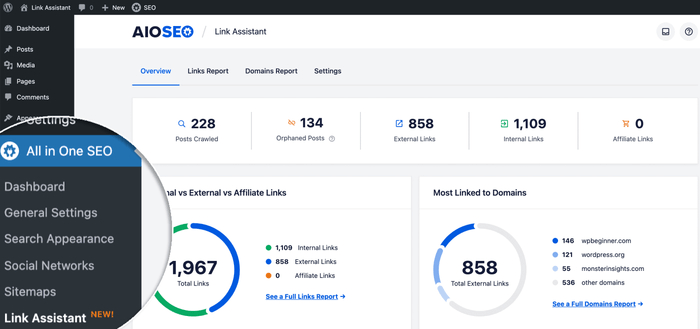
If you’re not using this in your content strategy yet, you’re missing out on an opportunity to rank for multiple keywords and topics.
Building topic clusters is one of the WordPress SEO tips you should implement religiously, as it has the potential to help you outrank your competitors.
9. Use SEO-friendly URL Structures
SEO-friendly URLs contain words that clearly explain your page’s content. They’re easy to read for both humans and search engines. Here’s an example:
http://www.example.com/wordpress-seo-tips/This URL is short, organized, and easy to read. Search engines and online users can tell what the web page is about
On the other hand, unoptimized URLs are disorganized and long. They usually include numbers, letters, and special characters.
https://www.example.com/?p=10467X&UKEwiv9vuz1tXsAhUThis type of URL can hurt your SEO, and you should take a few moments to optimize your URLs. For tips, check out our guide on the best WordPress permalink structure.
10. Watch Your Image SEO
Images are a great addition to your content, but they can be tricky regarding website optimization. If not handled correctly, images can slow down your site. That’s why one of the most important WordPress SEO tips to remember is Image SEO. However,
One way of optimizing your images is by compressing them. Image compression shrinks image files without taking away the quality. That’s why we suggest compressing images before uploading them to WordPress.
Along with compressing images, you should also add a title and alt text to photos. Alt text stands for “alternative text.”
The alt text and title help Google understand what your images are. This is also a helpful tool for someone with vision loss.
Check out our image SEO guide for detailed information on optimizing images.
11. Optimizing Search Snippets (SEO Title Tag and Meta Tag)
Optimizing your search snippets is a great way of improving your organic CTR on SERPs. A search snippet is the short blurb of your page that search engines display on their results pages.

It comprises of the URL, SEO title, and the meta description. And all these must be optimized. We’ve already looked at optimizing your URL, so we’ll focus on the SEO title and meta description in this section.
There are 3 main elements to focus on when optimizing these 2 search snippet elements:
- Use your focus keyword, preferably at the beginning
- Highlight the intent of the article
- Stick to the character limit
Check out our guide on crafting killer SEO title tags for more information. You can also check out our tutorial on using AI to write meta descriptions.
12. Add Internal Links
Internal linking means adding links to and from the pages on your site. We call these links “internal” because they’re within your website.
Internal linking is a powerful SEO practice as it helps:
- Keep readers on your site for longer
- Distribute “link juice” across your site
- Search engines better understand what your site is about
- Improve crawling and indexing
- Improve site navigation
But as your website grows, remembering all the articles you can link to becomes next to impossible. Manually adding internal links becomes impossible. That’s why you should consider a tool like AIOSEO’s Link Assistant.

Link Assistant helps you build strategic internal links on autopilot, making the task much easier. In addition, it also shows the orphaned pages on your site. These are pages without any internal links, a problem that can hurt your SEO and user experience (UX).
To make internal linking easy and fast, Link Assistant will suggest which articles to link to in your content and the anchor text to use. You can include all link suggestions at once or add them individually as you vet them.
Click here to learn more about how to improve internal link building on your site. This is one of the many WordPress SEO tips that should be non-negotiable.
13. Implement Google E-E-A-T
Google’s E-E-A-T stands for Expertise, Experience, Authoritativeness, and Trustworthiness. It is a set of criteria Google uses to assess the quality of content on the web, particularly pages that deal with topics related to health and finance. It’s also important for any other areas where accuracy and reliability are crucial. These are often called YMYL (your money, your life) pages/sites.
Implementing Google’s E-E-A-T content quality guidelines is easier if you have a plugin like AIOSEO. This is thanks to the Author SEO module.

This module enables you to add information to your user profiles:
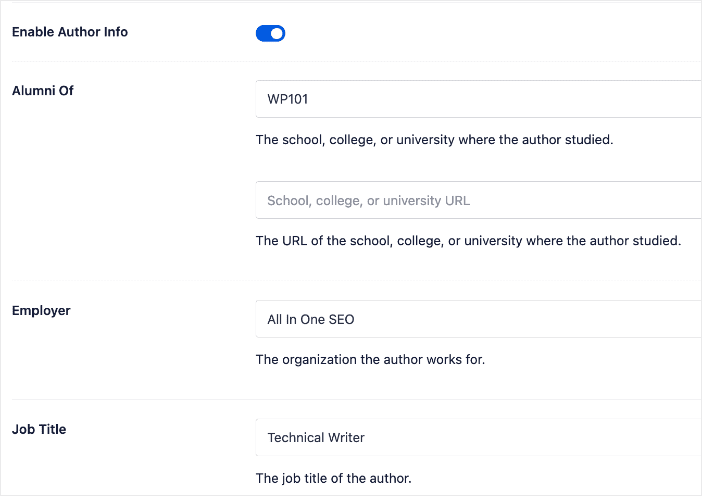
Besides general author info, you can also add your areas of expertise:

All this information points to your experience and expertise in your field. It also helps enhance your authority and trustworthiness. Coupled with the JSON schema markup, it proves to search engines that you’re qualified to talk about the subject. This helps you rank higher in searches around your keyword.
All this information helps you demonstrate Google E-E-A-T, resulting in improved author SEO and better rankings.
Here’s how Safe in the Seat, a car seat safety website grew its organic traffic by 362% in 6 months. One of their main strategies was embodying E-E-A-T in their content.
14. Target Google’s People Also Ask (PAA) Section
Another WordPress SEO tip you should strongly consider is targeting Google’s People Also Ask (PAA) section. Google’s People Also Ask (PAA) refers to related questions searchers may have about your particular topic.
The PAA section of Google’s SERPs is a prominent feature that gives publishers an opportunity to bolster their visibility on search engines further.
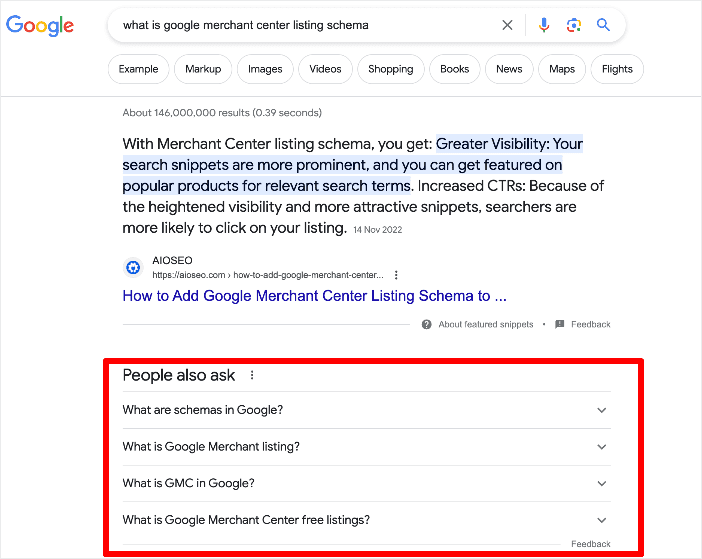
Optimizing for the PAA section also helps you bolster your semantic SEO strategy. This is because answering the common questions users ask in relation to your primary keyword helps you create content with semantic depth. It also helps you capture traffic for long-tail keywords.
You can check out our guide to optimizing for Google’s people also ask section for step-by-step instructions. Here’s a case study of how a food blog optimized its content for the PAA section and grew traffic by 508% in 3 months.
Need a case study on this WordPress SEO tip? Check out how a cybersecurity site catapulted traffic by 3,336% YoY by targeting Google’s PAA section.
Off-page SEO Tips
15. Build Backlinks
Backlinks are links from another site pointing to your site. They are considered the most valuable type of link as they are a vote of confidence in your content, both to search engines and users. As a result, the more high-quality backlinks you build, the higher your chances of ranking high on SERPs. A few ways to build backlinks include:
- Guest blogging: Guest blogging (guest posting) refers to the practice of creating content for publishing on a site other than yours. Most publications will allow you to link back to your site in the content itself and the author bio.
- Link building outreach: Link building outreach campaigns involve reaching out to publishers with a valuable post for them to link to.
- Influencer outreach: Collaborating with influencers on content is a great way to gain backlinks and drive relevant traffic to your site.
Invest time, effort and resources into building backlinks. These will help boost your authority, rankings, and traffic. Check out our link building guide for more tips on both internal link building and building backlinks.
16. Leverage Social Media Marketing
Leveraging social media is another great way to drive traffic to your WordPress site. Share your content with your social media network to get more people to see and engage with it. Plus, a social media presence is a great way to build social proof and credibility.
Consider using a WordPress social media plugin to help you manage your social media presence professionally. You can use these to integrate social media into your website, making it easier for you to reach more people and that without solely relying on search engines.
If you want an in-depth look at the difference between social media and SEO, check out our post on SEO vs. social media.
17. Watch Your Online Reviews
Keeping an eye on what people say about your brand is an important part of off-page SEO. That’s why you should keep tabs on online reviews and reputation management.
A great way to boost positive mentions of your brand is by encouraging your genuine customers to leave reviews. You can even use these to add review schema on your site. This will help boost your credibility and increase the trust factor, both essential in meeting Google’s E-E-A-T standards.
18. Be Proactive about Reputation Management
Particularly if your brand is new, this is one of the WordPress SEO tips you must keep a close eye on.
Online reputation management (ORM) is the practice of managing how people perceive your brand on search engines and other digital platforms. This involves monitoring online mentions of your brand, products, and services to ensure your business is perceived positively.
However, you won’t always get positive feedback from customers. Sometimes, you may receive bad reviews and negative comments from people who have interacted with your brand. And in other instances, unscrupulous marketers may use negative content to put your brand in disrepute.
This is where online reputation management comes in.
You can use it to steer the narrative people see in your favor. Doing so helps you protect your brand reputation. It also results in you building brand credibility and authority, leading to more people trusting your brand. A few reputation management tips include:
- Using FAQs to address customer concerns
- Monitor your search rankings for important keywords
- Be active on social media
- Keep an eye on brand mentions
Steer the narrative in your favor by creating positive content on all your major platforms. Apply SEO best practices to ensure that people see your narrative first.
Technical SEO Tips
19. Site Architecture and Navigation
Site architecture refers to the way pages on your website are structured, organized, grouped, and linked together. Unfortunately, this is one of the WordPress SEO tips many beginners neglect.
Your site architecture, done well, can help users and search engines easily find what they are looking for on your site. From a user point of view, this results in increased time on site, signaling to search engines that your site offers a positive UX and valuable content.
A few factors that can influence your site architecture include:
- Navigation menus
- Categorization
- URL structures
- Breadcrumbs
- Internal linking
Remember, search engines are all about providing users with a positive UX. And on your site, one of the most significant elements contributing to UX is your site architecture. So, make sure you optimize it for SEO.
20. XML Sitemap Implementation
One of the WordPress SEO tips beginners fear is implementing an XML sitemap.
An XML sitemap is a list of every important URL on your site. It helps search engines prioritize these URLs when crawling your site.
If you don’t upload an XML sitemap, search engines like Google may have trouble identifying your web pages.
Thankfully, creating an XML sitemap is super easy with AIOSEO. To generate a sitemap, go to All in One SEO » Sitemaps.
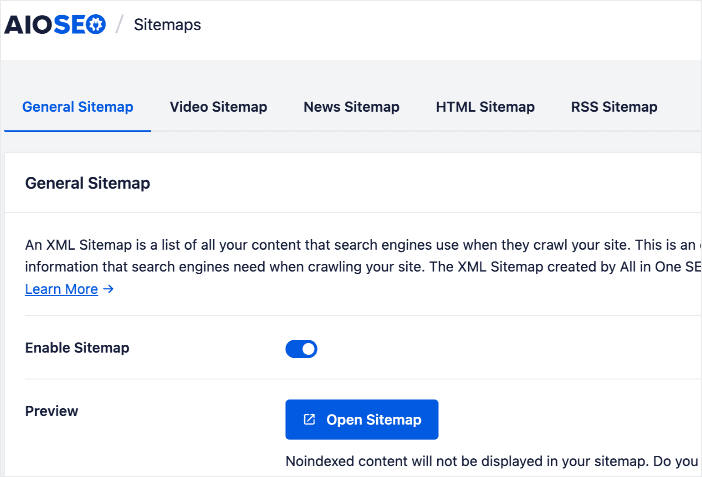
When you scroll down, you’ll notice a list of Sitemap settings. These settings let you choose what pages you’d like to add.
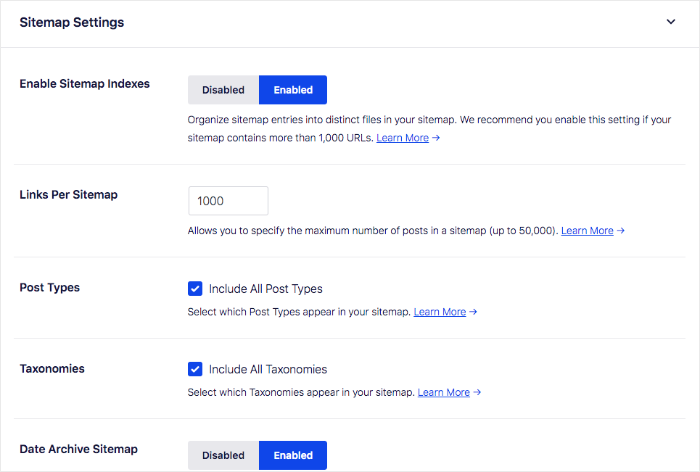
Make sure to set the toggle to Enable Sitemap Indexes option.
Check out our article on XML sitemaps vs. All in One SEO for more details.
21. Implement Schema Markup
One of the WordPress SEO tips professionals live by is implementing Schema markup.
Adding schema markup is another excellent way to enhance your semantic SEO.
Schema markup, often called Schema.org markup or structured data, is a semantic vocabulary (code) used to provide search engines with specific details about the content on a web page. In short, it makes it easier for search engines to understand your content.
Despite schema markup being code, you don’t need coding knowledge to implement it. You simply need to use an SEO plugin that supports it.
Adding schema markup is super easy with AIOSEO’s Next-gen Schema Generator. This no-code module adds the schema code for you in the background. All you have to do is choose your schema type in the Schema Catalog.
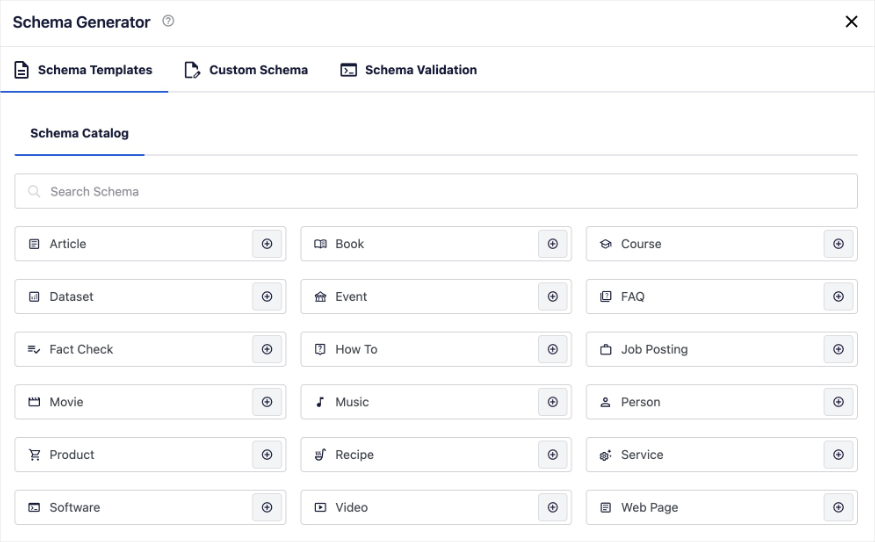
Adding schema markup is also a great way to enhance your chances of getting rich snippets and featured snippets.
Check out how Iowa Girl Eats, a gluten-free food blog, grew traffic by 508% in 3 months. One of their winning SEO strategies was implementing schema markup. Read the case study here.
22. Site Speed Optimization
Site speed plays a huge role in SEO. It’s an important element of SEO that impacts your conversion rates, bounce rates, page views, and other metrics essential to a healthy website.
Improving your site speed is critical as it impacts your website’s user experience (UX). As a result, it has also become a significant ranking factor in Google’s Page Experience algorithm.
A few ways to improve your site speed include:
- Using a fast web hosting provider
- Using an SEO-friendly WordPress theme
- Compressing images
Pay careful to WordPress SEO tips like site speed, as they also impact your conversion rates. Slow load times can result in high bounce rates, causing you to lose precious visitors.
23. Pay Attention to Site Security
Website security is another important WordPress SEO tip you should prioritize. Security is a key ranking factor as search engines want to ensure the websites they recommend are secure and protect users’ privacy.
And that’s why implementing SSL / HTTPS on your site is strongly recommended. Once you install an SSL certificate on your site, a padlock sign will appear in the address bar, showing your visitors that they’re on a secure page.
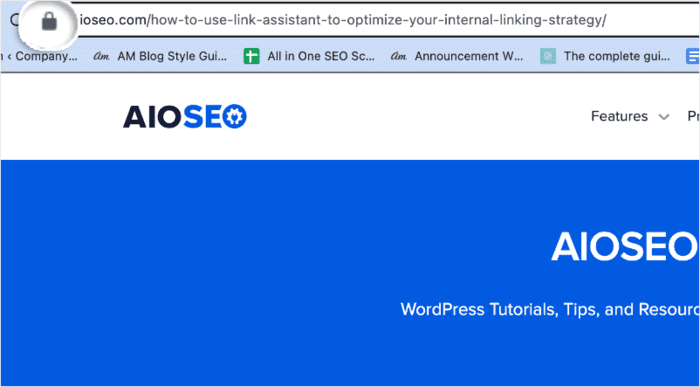
In addition, your website address will begin with HTTPS instead of just HTTP. These visual queues are a great way to gain user trust, an important factor in encouraging repeat visitors.
Check out our article on HTTPS and SEO for more details on the impact site security has on your search rankings.
24. Eliminate 404 Errors
As your website grows and evolves, you may change some pages and delete others. If this process is not handled properly, it could result in 404 errors on your site.
404 errors in WordPress mean that the URL or web page a user is trying to visit is broken or the page doesn’t exist anymore. Too many 404 errors on your website can negatively impact your rankings.
Fortunately, if you’re an AIOSEO user, you can easily avoid 404 errors on your WordPress site. And this is automated by our Slug Monitor. Whenever the Slug Monitor detects a change in a URL, it prompts you to add a redirect.
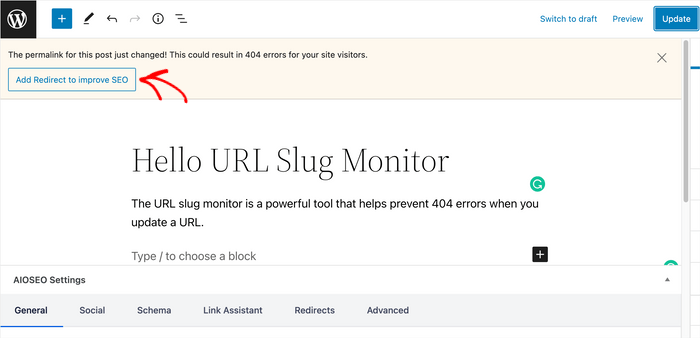
Clicking the “Add Redirect to Improve SEO” button will open a modal where you can automatically add a redirect from the old URL to the new URL.
Alternatively, to avoid 404 errors on your site, you can consider adding automatic redirects to your Homepage.
Avoiding 404 errors is one of the WordPress SEO tips that ensures a positive user experience and makes it easier for search engines to crawl your site. Both contribute to better rankings for your site.
25. Find and Fix Broken Links
Broken links are bad for SEO as they result in crawl errors. This is because broken links disrupt the normal flow of the crawling process. Instead of efficiently following links from one page to another, the crawler encounters dead ends. This may result in wasted crawling resources and potentially leaving other pages unexplored.
Besides crawl errors, broken links can lead to a negative user experience. This, too, can harm your SEO.
That’s why you should regularly monitor your site for broken links. This can be easily done with AIOSEO’s Broken Link Checker, a tool that crawls your site to find broken links.

This powerful tool does more than find broken links. It also offers you solutions for fixing them.
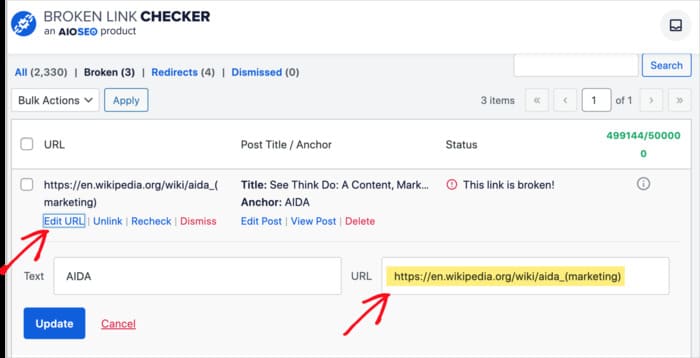
Because Broken Link Checker automatically checks your site for broken links, you reduce the occurrence of crawl errors. This is definitely one of the WordPress SEO tips you shouldn’t compromise on.
Check out our guide on finding and fixing broken links for detailed instructions on eliminating broken links on your site.
WordPress SEO Tips: Your FAQs Answered:
Is WordPress still the best for SEO?
Yes, WordPress remains one of the best platforms for SEO. Its user-friendly interface, extensive plugin ecosystem, and SEO-focused features make it a powerful choice. However, success depends on proper optimization and content quality.
What is the best plugin for WordPress SEO?
The best plugin for WordPress SEO is All In One SEO (AIOSEO). It has many features and modules to help you rank your site and content higher on SERPs. It’s a no-code plugin that anyone can use. Plus, it helps you implement many WordPress SEO tips on this list.
Master WordPress SEO for Better Search Rankings
Mastering SEO is crucial to growing your business. Thankfully, WordPress SEO isn’t complicated. Just follow the tips above, and you’ll improve your search rankings.
We hope this post has helped you know the top WordPress SEO tips you can implement on your site. You may also want to check out other articles on our blog, like our guide to common SEO mistakes to avoid or our tutorial on using HTML tags for SEO.
If you found this article helpful, then please subscribe to our YouTube Channel. You’ll find many more helpful tutorials there. You can also follow us on Twitter, LinkedIn, or Facebook to stay in the loop.
Disclosure: Our content is reader-supported. This means if you click on some of our links, then we may earn a commission. We only recommend products that we believe will add value to our readers.
